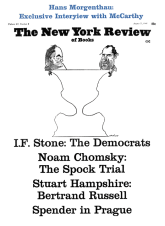In response to:
Unmodern Men from the February 1, 1968 issue
To the Editors:
Mr. Neal Ascherson’s review of my book Beyond Eagle and Swastika: German Nationalism Since 1945 reveals that there has occurred between author and critic a massive failure of communication. Is one of the main theses of my book so obscurely put that a benevolent critic like Mr. Ascherson cannot discover it, or did he—facing a 1600-page work and under pressure from an approaching deadline—skip an entire Part (not merely individual pages) of the book, including the “Conclusion”? [NYR, Feb. 1].
Mr. Ascherson reports on the New Left in Germany and their rejection of the “notion that the development of a settled and secure elite is a desirable kind of modernization.” “Their criticism,” Mr. Ascherson goes on to say, “can also be used against Kurt Tauber’s huge work on postwar rightist nationalism in West Germany. The New Left looks with irritation and alarm on the foreign fuss about the National Democrats. Bad the National Democrats may be, but it is a deception to see the right-wing radicals as the source of reemerging nationalism and authoritarianism. The real danger is the extent to which the major parties have been infected with these elements, always present in German society, in part through their response to such splinter groups. Professor Tauber does not go into this, but it is a formidable argument.”
I could not agree more with Mr. Ascherson that this is a formidable argument. Indeed, it is so formidable that I devoted to it a 100 page Part on “Restoration” (Chapters XVII and XVIII), as well as many discussions throughout the book, such as in Chapters VIII (pp. 258-266, 298-315), IX (pp. 357-362), X (pp. 369-370, 372-385, 428-434, 449, 453), XI (pp. 593-594), XIV (p. 754), and XV (pp. 765-769), to name only a few.
In short, what Mr. Ascherson accuses me of having ignored happens to be one of my main theses. As such it receives due recapitulation in the Conclusion. There I also warned against the danger of becoming so mesmerized by the chimera of neo-Nazism as to overlook the far more significant traditionalist-nationalist social restoration. “The irony of the German situation,” I wrote, “seems to us to lie in the high probability that the socioeconomic and political forces that effected the amazing integration of potentially dangerous National Oppositionists into the Bonn Republic are also the very forces that have prevented a genuine integration and hence are calling into question the future constitutional development of a democratic Germany.”
Mr. Ascherson, furthermore, wonders “how Professor Tauber can produce a monumental history of a political movement without a sociological analysis of its representatives and its support.” The answer is he could not and he did not: Right-wing support is extensively analyzed in connection with election data (e.g., pp. 68-70, 74-76, 78, 89-94, 115-116, 699-706, 750, 803-809, 842-843, 853-855). The background of Rightist leaders and representatives is stressed throughout the book (e.g., pp. 47-89, 101-115, 122-127, 129, 132-135, 141-145, 402-411, 691-692, 727-742, 771-788, 795-796, 886-889, 896-905, 921-932), to substantiate another of its main theses, namely that the failure of radical conservatism and nationalism in postwar Germany has been due largely to inadequate leadership. Finally, the actual and potential crisis strata available for nationalist mobilization are repeatedly discussed.
Kurt P. Tauber
Associate Professor of Political Science
Williams College
Neal Ascherson replies:
I can assure Professor Tauber that his book was read, but a failure of communication has none the less occurred. Looking back through the references he offers, it still seems to me that he “does not go into” the infection of the major parties by the doctrines and the men of traditional nationalism and authoritarianism. The transactions between the CDU and the right-wing parties are all documented: so—impressively—is the penetration into the Foreign Office, the judiciary, the universities, and so on. What I missed—and perhaps I should have made this clearer—were studies of the CDU and the SPD as they now are, and of the extent to which traditional nationalist feelings provide their slogans and their support. This leads on to the matter of the “sociological analysis.” It seemed to me that only one of the passages Professor Tauber now refers to, the account of SRP support on pages 699-706, constituted an analysis of party support by social class, and that a particular instance. At the end of the book, I was left with a sense of having been fed political information to satisfy the most demanding appetite, but there remained a craving to know “what sort of people vote for this sort of party”—classified not by their party-political antecedents as voting blocs but according to how they earn their living and regard themselves socially.
This Issue
August 22, 1968



